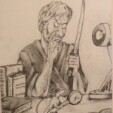There are nine generations of the mainline Tadayoshi school. In the vast majority of cases they signed Tachi-mei on long swords and Katana-mei on Wakazashi. The early smiths also made Tanto and some, but few Naginata.
They have always been very popular, as a result they have been copied and many, very many, gimei blades exist, some very good quality ones others not so good,
The mei on this blade does not look right for the manline family or daimei from the leading students. The Hamon is not what one would normally associate with this school, although again they did make various styles (the vast majority Sugha)
Based on the images (first two) I think this is very likely to be gimei.
Paul B


